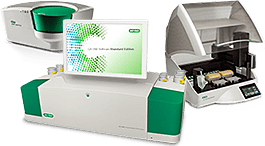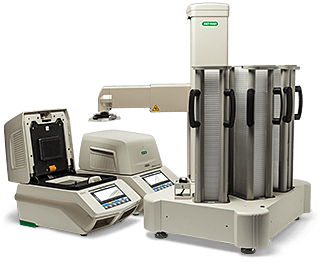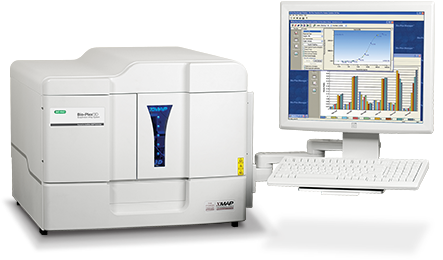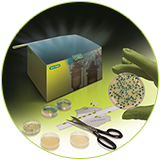
On This Page |
Solutions for Gene Editing Workflows | CRISPR Gene Editing Workflow | Companion Products for Gene Editing Workflows | Resources |
Solutions for Gene Editing Workflows
CRISPR gene editing provides versatile workflows that enable researchers to edit their desired target genes efficiently and accelerate therapeutic development. Explore our solutions for gene editing workflows.
CRISPR Gene Editing Tools
The advent of CRISPR as a gene editing tool has revolutionized drug discovery and development in a very short time. The CRISPR-Cas9 system uses short RNAs to direct the Cas9 nuclease to target specific DNA sequences for editing. Because CRISPR uses RNA rather than a protein to target nuclease activity, CRISPR-Cas9 activity can be easily and accurately retargeted by synthesizing a new guide RNA (gRNA). The gRNA effector also makes this technique amenable to high-order multiplexing, for example, large-scale screening using hundreds or thousands of gRNAs in a single experiment. Consequently, complex studies that once took years to develop in animal models can now be completed in just a few months and at a fraction of the cost.
The speed, low cost, and transferability of CRISPR-Cas9 gene editing to almost any species is redefining what is possible in R&D. More and more new applications for CRISPR are published monthly. From creating complex, multi-gene disease models and whole-genome knockout screens in less than two months to creating inducible systems and generating Cas9 variants that act as epigenetic regulators, the development of CRISPR tools has not only accelerated R&D, CRISPR-Cas9 gene editing is emerging as part of the solution for curbing the cost of drug development and reducing late-stage failure rates.
CRISPR Gene Editing Workflow

Transfection
Identification of the best method for delivering the CRISPR-Cas9 system into the cells of interest is the first step in the gene editing workflow. When considering which transfection method to use, transfer efficiency and subsequent cell viability are important factors.

Enrichment and Single-Cell Isolation
Enrichment for cells of interest occurs after cells have been transfected. In this step, only those cells that carry the desired edits are identified and expanded. Enrichment also reduces the number of passages cells undergo, ensuring healthy cells for downstream analysis.

Confirmation of Edits
It is important to confirm that target cells have been successfully edited prior to moving on to downstream assays. This can be accomplished either through direct detection of edits using genomic methods or through indirect detection using cellular or proteomic methods.

Downstream Analysis
Phenotype investigation can begin once it has been confirmed that the cells are correctly edited. Further perturbation of the system with a drug as part of a cell-based assay may be desired during target or lead discovery and validation.
Companion Products for Gene Editing Workflows

Gene Pulser Xcell Electroporation Systems
- Universal electroporation — transfects all cell types: primary and stem cells, bacteria and yeast
- Preset protocols — includes the most common mammalian and bacterial cell types
- Protocol library — collection of electroporation protocols for every cell type including primary, immortal, and bacterial cells

TransFectin Lipid Reagent
- High-efficiency transfections and transgene activity for a broad range of cells
- Low cytotoxicity helps maintain cell viability
- Flexibility — excellent performance at culture densities between 40—90% and in the presence or absence of serum-containing medium
- Simple 3-step protocol and no post-transfection media changes required for most cell types

ZOE Fluorescent Cell Imager
- Simplified cell imaging — the intuitive touch-screen interface allows users to view cells, capture images, and create multichannel merges with minimal training
- Flexible operation — brightfield and three fluorescence channels enable use for routine cell culture applications and more sophisticated imaging applications

TC20 Automated Cell Counter
- Accurate cell counts in one simple step
- Auto-focus technology and sophisticated cell-counting algorithm

S3e Cell Sorter
- Utilizes stream-in-air fluid dynamics for a more gentle high-speed sort
- Features Lossless Cell Sorting mode for maximum recovery of rare-cell populations
- Sort status email and text notifications allow the user to multitask during a sort

ZOE Fluorescent Cell Imager
- Simplified cell imaging — the intuitive touch-screen interface allows users to view cells, capture images, and create multichannel merges with minimal training
- Flexible operation — brightfield and three fluorescence channels enable use for routine cell culture applications and more sophisticated imaging applications

QX200 Droplet Digital PCR System
- Detection of small or large edits with absolute quantification
- Most precise and sensitive digital PCR solution for all applications
- Flexible digital PCR chemistry — optimized for TaqMan Hydrolysis Probe and EvaGreen Assays
- Flexible assay setup for high sensitivity or high throughput

CFX Real-Time PCR Detection System
- Sensitive, reliable detection for singleplex and multiplex real-time PCR reactions
- 2–5 color multiplexing, advanced optical technology, and precise gradient temperature control
- CFX Maestro Software for superior data collection, visualization, and statistical analysis

iProof High-Fidelity Real-Time PCR Reagents
- High fidelity — iProof DNA polymerase is 52-fold more accurate than Taq polymerase
- Speed — high processivity dramatically reduces extension (15–30 sec/kb) and overall run times
- Successful amplification of long products with higher yields — fragments up to 37 kb are amplified in less time and with less enzyme (0.25–1 unit/reaction)

Real-Time PCR Supermixes and Kits
- Any instrument — universal reference dye is compatible with all qPCR platforms
- Any chemistry — supermixes for SYBR Green or probe-based detection chemistry
- Any conditions — our patented Sso7d fusion polymerase guarantees superior qPCR performance under varying and/or challenging conditions

V3 Western Workflow — Visualize, Verify, Validate
A five-step streamlined western blotting protocol with innovative tools including proprietary stain-free imaging:
- Faster run and transfer times
- Checkpoints at every step
- Quantitation made simple

PrecisionAb Validated Western Blotting Antibodies
- Robust validation — performed on up to 12 different cell lysates with endogenous protein levels
- Reproducible data — stringent batch-to-batch QC
- High specificity and sensitivity — low nonspecific binding and strong signal from target proteins

ZOE Fluorescent Cell Imager
- Simplified cell imaging — the intuitive touch-screen interface allows users to view cells, capture images, and create multichannel merges with minimal training
- Flexible operation — brightfield and three fluorescence channels enable use for routine cell culture applications and more sophisticated imaging applications

CFX Automation System II
- Works with all CFX Real-Time PCR Systems to facilitate automated workflows, large-volume data generation, and rapid data analysis
- Saves valuable lab space — run two CFX Systems with a single plate handler in a compact footprint
- Run up to up to 84 plates per day

QX200 Droplet Digital PCR System
- Detection of small or large edits with absolute quantification
- Most precise and sensitive digital PCR solution for all applications
- Digital PCR chemistry optimized for TaqMan hydrolysis probes or EvaGreen assays
- Flexible assay setup for high sensitivity or high throughput

ddPCR Genome Edit Detection Assays
- Enable rapid assessment of HDR and NHEJ edits generated by CRISPR-Cas9 system or other targeted genome editing tools
- Detect editing events present at frequencies ≤ 0.5%
- Provide absolute quantification of genome editing events from as little as 5 ng of total gDNA (cells in a single well of a 96-well plate)

ZE5 Cell Analyzer
- Analysis of up to 30 parameters from a single sample, expanding the number of biomarkers that can be monitored in a cell-based assay
- Measures rare or transient cell populations quickly

V3 Western Workflow — Visualize, Verify, Validate
A five-step streamlined western blotting protocol with innovative tools including proprietary stain-free imaging:
- Faster run and transfer times
- Checkpoints at every step
- Quantitation made simple

Bio-Plex Multiplex Immunoassays
- Measure up to 500 unique analytes in a single sample
- Assay and panels for over 450 biologically relevant targets: inflammation, disease, cancer, cell signaling and growth, apoptosis, toxicity, and more
- Choose premade or custom configurations, or develop your own assays for new targets

Bio-Plex Readers and Tools
- Premium instruments, software, calibration, and validation kits to ensure consistent, reproducible results
- Use our Bio-Plex Multiplex Immunoassays, powered by Luminex xMAP Technology
- Measure up to 500 unique analytes in a single sample
Resources

From megaTALs to CRISPR: The Many Ways to Edit a Gene

Erasing Disease: How Gene Editing is Changing Genetic Therapies

CRISPR: Changing the Pace of BioPharma R&D
Documents

Speed Time to Results by Incorporating Flow Cytometry into the CRISPR-Cas9 Gene Editing Workflow
(PDF 572 KB)
Publication List: Electroporation of Nucleic Acids and Proteins for CRISPR-Related Gene Editing
(PDF 119 KB)
CRISPR Gene Editing Workflow
(PDF 3.1 MB)
Gene Editing: Clearing the Roadblocks to a New Class of Therapeutics
(PDF 340 KB)
Ultra-Sensitive Quantification of Genome Editing Events Using Droplet Digital PCR
(PDF 614 KB)
Fast and Efficient Workflow to Monitor CRISPR-Cas9 Gene Editing in Haploid Cell Lines
(PDF 665 KB)
Droplet Digital PCR Applications Guide
(PDF 3.9 MB)
Reliable Single-Cell Sorting with Bio-Rad's S3e Cell Sorter
(PDF 508 KB)
Real-Time qPCR as a Tool for Evaluating RNAi-Mediated Gene Silencing
(PDF 265 KB)

